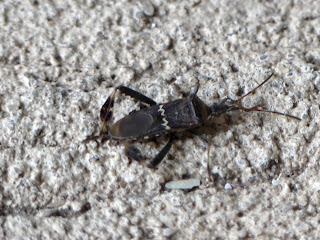Western Leaf-footed Bug
I think this was a Western Leaf-footed Bug from last February. If this is correct, then this is another species of bug that's spreading eastward. An article from a century ago claims they were no closer to New Jersey than Nebraska, the Insect Identification webpage has them in Ohio, Bug Guide lists New Jersey and Massachusetts as northeastern states they're now in, and this article abstract says they could spread as effectively as the related Western Conifer Seed Bug that's known to be in this area.
You're supposed to be able to identify the Western Leaf-footed Bug by a "spike" at the front of the head. Unfortunately my picture doesn't have enough detail to tell if such a spike is there. I'm mostly basing this ID on the iNaturalist suggested ID and Penn State describing the prominent white zigzag on the back.
Although they can be pests in pistachio orchards, it sounds like these bugs are fairly flexible eaters, so there could be a viable food source around my apartment. It also sounds like they can overwinter as adults, so perhaps that's what this bug was doing until we had a warm day in February.
With their wings up, the back of their abdomen has black-and-yellow patterns that resembles wasps, especially yellowjackets. They can also produce a foul-smelling odor when attacked. As bugs that suck fluids from plants, you're unlikely to get bitten by 1 unless you're handling it.
I didn't get a clear idea of why bugs like the Western Leaf-footed Bug and Western Conifer Seed Bug have spread eastward. It's easy to think that us humans were somehow involved, whether they're hitchhiking on our transportation, or changing the flora in a region to something they can eat, or maybe eliminating/reducing the population of a predator that used to suppress their numbers; we really do have pronounced, extensive effects on ecosystems. Still, FAIK these bugs could have spread eastward even without us.
 |
| February 12, 2023 at Sunny Slope Road Photo 263681034, (c) jpviolette, some rights reserved (CC BY-NC) |



Comments
Post a Comment